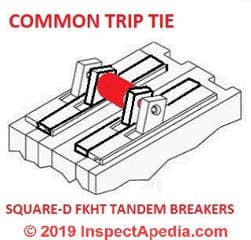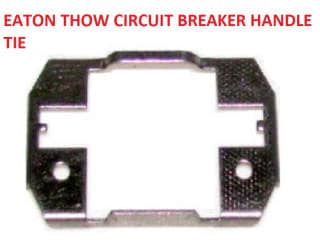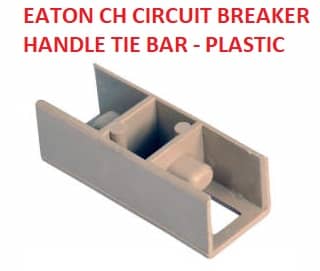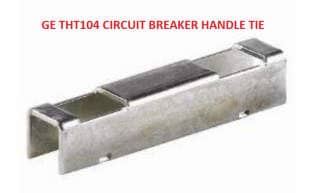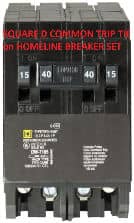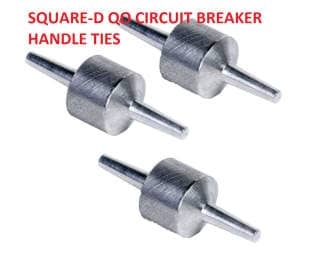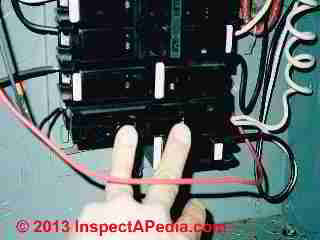 Circuit Breaker Handle Ties
Circuit Breaker Handle Ties
Common trip ties for 2-wire or 240V circuit protection
- POST a QUESTION or COMMENT about this article topic.
This article describes the use of handles to tie adjacent circuit breaker handles or toggle switches together to force both circuit breakers off should one of them experience a short or over-current.
This handle tie is required for 240VAC circuits and for multi-wire branch circuit breakers.
Page top photo: a pair of full-width circuit breakers used to power a multi-wire branch circuit.
Watch out: This wiring is unsafe because arranged as shown it is not possible to force the pair of breakers to trip off should a short or over-current occur on one leg of this circuit.
InspectAPedia tolerates no conflicts of interest. We have no relationship with advertisers, products, or services discussed at this website.
- Daniel Friedman, Publisher/Editor/Author - See WHO ARE WE?
Types of Common Trip Tie Handle Connections for Circuit Breakers
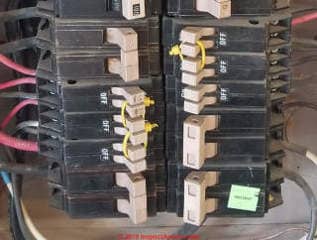 This article describes methods for joining two adjacent circuit breakers so that both will trip off as required.
This article describes methods for joining two adjacent circuit breakers so that both will trip off as required.
Using the U.S. National Electrical Code as an example, either common internal trip ties on newer two-pole circuit breakers OR on some older circuti breakers an external trip tile affixed to the toggle switch handles is required by NEC 240.20(B) in some cases, such as when the circuit breaker pair is powering a 240VAC circuit or on a multi wire branch circuit sharing a common neutral wire.
That NEC paragraph requires that
(B) Disconnecting Means.
Each multi-wire branch circuit shall be provided with a means that will simultaneously disconnect all ungrounded conductors at the point where the branch circuit originates.
Tandem circuit breakers (two breakers powering two circuits fit into a single original breaker slot in a panel) also trip together.
Watch out: in our opinion and that of others, a handle-only connection in some circuit breaker designs may leave one breaker "on" and the other "off" - a dangerous condition because of the chance of fooling the electrician or homeowner into thinking that all electrical power is off when it is not.
NEC 210-4-b makes clear that split receptacles must be protected by a simultaneous disconnect to all ungrounded (hot) conductors (i.e. use a double-pole breaker with a common trip tie installed). NEC Paragraph 210-4 addresses multiwire branch circuits.
Even if a circuit breaker pair can be physically connected by a common handle (not possible in the case of Pushmatic™ breakers) the level of protection is not the same as that provided by two-pole or double-pole circuit breakers with a common internal trip tie mechanism.
Note that many tandem (half-width or "thin") circuit breaker pairs that fit into a single circuit breaker slot in an electrical panel are designed with a common internal trip mechanism that will trip off both breakers should either of them sense an overcurrent.
However because both such breakes will be powering circuits on the same panel leg or (speaking loosely "phase), you cannot correctly wire a multiwire circuit (shared neutral) nor a 240V circuit from one such breaker pair. Instead you'd wire the multiwire circuit or a 240V circuit from the outside breakers of two tandem breaker pairs like the ones shown in Mr. Morgan's photo above.
There the yellow plastic ties indicate pairs of tandem circuit breakers that are powering multiwire branch circuits.
Watch out: as reader Harrison pointed out by comment (Mar 22 2023),
... it is worth delineating the distinction that modern breakers are not compatible with manual handle ties, but older breakers work in this way. I have noticed a common misconception amongst people that even newer breakers can be "handle tied" in this way to acheive common trip - It's just not acceptable for modern breakers.
But [it was] was totally acceptable back when common trip was achievable on older breakers using this method.
It's important to distinguish WHEN common trip is going to happen vs when it is not.
That is, an over-current on either pole of a two-pole 240V (or shared neutral) circuit needs to trip off both of the individual poles or breakers. Leaving one pole or "leg" on or live and the other off or dead is unsafe.
Question: how to tie together narrow-width tandem circuit breaker handles
2019/05/16 Charles Morgan said:
When narrow-width breakers are used in a multi-wire circuit (like 10B and 12A in your example) is there an accepted method of physically tying the breakers together? Right now I'm using tie-wraps.
This Q&A were posted originally
Photo, provided by InspectApedia.com reader CM illustrates a not-approved and probably not-reliable DIY method for joining adjacent toggle switch handles in a tandem circuit breaker pair used to power multi-wire branch circuits in a U.S. home.
Reply:
Charles
Thank you for the interesting question and photo: how to find common trip-ties for narrow-width circuit breakers.
Watch out: no do-it-yourself or "home made" circuit breaker handle ties such as screws, nails, or plastic ties are acceptable: they are unsafe, violate electrical code, and risk fire or shock, even death to an an electrician working on such circuits.
There are several concerns but the most-basic is that we're relying on a DIY circuit breaker trip tie that may not perform reliably nor safely to turn BOTH breakers off should an overcurrent or short occur on one of the circuits of the pair. Also we're modifying a circuit breaker outside of its listed or design specifications.
It will help my research if you can tell me the circuit breaker brand and model - from the panel labeling and from labels on the circuit breakers - or post a sharp photo showing me the circuit breaker label.
Here's another example: Square-D provides a handle tie that joins alternate-breaker handles for thin (half-width) tandem circuit breakers in its FKHT circuit breaker series.
Above: this type of common trip tie for Square-D circuit breakers is used on Square-D breaker models FA, FI, KA, KI breakers, 2 to 3 pole models and has UL approval.
In your photo I don't see that design. So if your breaker manufacturer permits adjoining adjacent half-width or "tandem" circuit breaker toggles it'd be with a clip-over handle tie such as others .
Examples of Handle Ties for Circuit Breaker Toggle Switches
Watch out:Select the proper and approved handle tie for your specific brand and model circuit breaker pair. Again from the US NEC:
6.1.5.3 Single-pole circuit breakers rated at 120/240 V ac or 125/250 V DC shall have provision for the use of handle ties. Handle ties, when installed, shall:
a) Operate both circuit breakers when either circuit breaker handle is manually operated;
b) Not be readily removable; and
c) Not obscure the ampere marking on either circuit breaker.
Watch out: While most residential circuit breakers are "slash-rated" and can be tied together, not all circuit breakers are so rated nor designed for that use. Check the rating of your breakers.
7.1.1.12 If a single-pole circuit breaker is rated at 120/240 V ac or 125/250 V dc, see 6.1.5.3, two such circuit breakers shall be tested together in the intended manner as a 2-pole independent-trip circuit breaker in the overload, endurance, interrupting, and dielectric voltage-withstand test described below. Two such ‘pairs’ of circuit breakers constitute a set.
The concern is that where a pair of joined circuit breakers must be installed so that if either trips, both breakers will switch off, if instead the handle tie or breaker design could permit just one breaker to turn off while the other remains on, the circuit is unsafe. A common example of this application is multiwire branch circuits that share a common neutral, discussed
Eaton Cutler Hammer Breaker Ties
Below: an Eaton Cutler Hammer THOW type circuit breaker handle tie.
Below: another Eaton CH circuit breaker tie bar, this one made of plastic.
GE Circuit Breaker Handle Ties
Below: a GE THT104 Circuit Breaker Handle Tie sold for retrofit to tie adjacent breaker handles together.
Below: another GE Circuit breaker toggle handle tie, this one for THQP 1/2-inch circuit breakers
Siemens Circuit Breaker Handle Ties
Siemens sells an add-on handle tie for joining circuit breakers, used with BQ, BQH, HBQ, BLH, HBL Circuit Breakers but yours appear to be a different breaker brand and model.
Square D Breaker Handle Ties
Above: the 40A breakers of this Square-D Homeline circuit breaker set are tied together with a factory-installed common-trip tie.
Below: Metal circuit breaker toggle ties for Square D QO-Series circuit breakers sold under the Homeline Tandem Breaker line. These connectors "convert adjacent tandem single-pole breakers to double-pole" (Home Depot).
You can see that a simple plastic or steel device inserts between adjacent tandem breaker toggles in adjacent tandem breakers in the panel. However breakers that are designed to permit that common trip tie are issued from the factory with holes in the circuit breaker toggle switches - holes intended to accommodate the common trip tie device. These handle ties are also sold in a plastic version shown below.
Watch out: rather than use home-made circuit breaker toggle ties or plastic ties or a nail or screw, use the manufacturer's recommended device for your specific circuit breaker brand and model. Otherwise the circuits you are wiring may not be properly protected and you risk fire, shock, or death.
A home-made or improperly selected and installed handle tie on a circuit breaker pair violates the listing of the product. In essence, it's "illegal".
...
Reader Comments, Questions & Answers About The Article Above
Below you will find questions and answers previously posted on this page at its page bottom reader comment box.
Reader Q&A - also see RECOMMENDED ARTICLES & FAQs
On 2023-03-18 by InspectApedia Editor - it's important for safety to describe the properties of this equipment
@Harrison,
Agreed.
Thank you for the discussion about tripping of two pole breakers.
Do keep in mind that here at InspectApedia, we include properties of all types and ages of circuit breakers so it's useful and often important for safety to describe the properties of this equipment accurately for the specific breaker age and type and more, often even the specific brand.
It would be dangerously misleading to allow a reader to think that a 1960's two pole FPE circuit breaker works the same way as modern breakers of other brands and worse, to allow such a reader to think that that old FPE two pole breaker is safe.
On 2023-03-16 by Harrison
@InspectApedia Editor, you are correct that a double pole will provide common trip if it's a single unit.
I'm saying that two individual single poles tied together with handle ties will not provide common trip, despite common belief to the contrary. It seemed to me that the article implied this.
The reason that two single poles tied together will not provide common trip is because the breakers are "trip free". If they encounter ANY resistance to tripping, they will simply trip internally leaving the handle unaffected.
They do not have sufficient force to transmit to the other breaker to trip, they will instead just trip internally themselves upon meeting the resistance of the other breaker's handle.
Although, I do concede that older breakers that are not "trip free" may be able to achieve common trip in this way.
It's worth noting though that NEWER breakers that are "TRIP free" CANNOT be converted to common trip using a handle tie, almost always, because they will simply not actually actuate the handle externally, they will just trip internally when they meet resistance and leave the other handle untripped.
If you are dealing with modern breakers the only way to get common trip is to have a double pole unit or a breaker marked "common trip"
On 2023-02-27 by InspectApedia Editor - modern two-pole breaker uses an internal trip mechanism so that an overcurrent on one leg of the circuit will trip both off
@Harrison,
Thank you for expressing your opinion. Respectfully, we don't think you're completely correct.
Having inspected a lot of electrical panels over the last 5 decades I, and others in the field, have seen quite a lot of installations and lots of variations.
A modern two-pole breaker, sold as a single physical unit, indeed uses an internal trip mechanism so that an overcurrent on one leg of the circuit will trip both off.
But there are thousands of electrical panels installed sporting individual circuit breakers whose toggles were designed to accept (or omit) a common trip tie between them. If the trip tie is missing, it's entirely possible for those breakers to trip individually - not both.
That's what was wanted IF the breakers were powering two independent 120 VAC circuits,
but it's not what was wanted if the installer wired an adjacent pair of individual breakers to operate a 240VAC device. Some brands and models of breaker were designed to permit that use - eg. providing toggles with a hole that accepts (or permits adding) a pin between them.
If the two pole breaker is in a single case, it'll have an internal common trip. We agree with you in that case.
IF two *individual* 120VAC breakers are found tied together with a trip tie, the trip tie is needed, not just to enable switching both off at once, but to (hopefully) trip off both breakers if either sees an over-current.
In fact, in my OPINION, that wiring and breaker installation is not the best practice; we've seen common trip tie breakers joined by a pin with enough slack in the connection that one breaker could be tripped off without tripping its pinned neighbor. We've seen others "tied" using amateur methods like a bit of wire or a finishing nail - an unreliable common trip tie that any savvy home inspector will call out as improper and unsafe.
But that's what's out there.
You might argue those circuit breakers that permit an "add-on" common trip tie between two neighbors are obsolete and ought to be replaced.
We're working to describe what's actually in the field, not just what's new, or ideal.
Thanks for the helpful comment, we'll keep it with the article, and we'll welcome your further comment.
On 2023-02-18 by Harrison
Hello,
I want to explain that this article's premise is fundamentally faulty. The handle ties do not ensure "common trip", because breakers are "internal trip". They will trip even if their handles are obstructed or held down. So the resistance of the other handle simply causes only one breaker to trip. This is fine though! The handle tie only serves to ensure simultaneous depowering of the circuit, it is NOT for common trip. If common trip is required, you must have a breaker that says COMMON TRIP on it.
Common trip is required for 240v appliances like dryers etc, but is not required for MWBC.
On 2022-11-10 by InspectApedia (Editor)
@Bob Koretsky,
If there's only one circuit breaker involved then I don't understand how common trip ties would be part of the discussion. Sorry if I've misunderstood.
On 2022-11-09 by Bob Koretsky
The picture at the top of your article shows trip levers tied together with yellow zip ties on different breakers, whose circuits I assuming share a common neutral. How about two circuits on the same breaker that share a common neutral? I have Siemens narrow-width breakers, QT2020.
On 2021-10-15 by inspectapedia.com.moderator - if one leg were to trip, would the other leg trip as well?
@Erwin Bordallo,
Thank you for the question.
No, this article does not suggest that two paired circuit breakers powering a 240 volt circuit and that do not use a common internal trip will both trip anyway if there is an over-current or short circuit on one leg of the circuit.
That's not the case.
It is precisely because an overcurrent on one leg in that design does not turn off both legs that a trip tie is required connecting both Breakers together so that if one trips the other is forced off as well.
It would be unsafe to leave a device half powered on and half powered off.
The problem with the mini circuit breakers for the 240 volt application that you are describing is that you are basically obtaining two circuit connections on a single bus or side of your electric panel.
So what was previously a 240 volt circuit cannot be connected to the two mini breakers without risking that you no longer have 240 volts to the device.
On 2021-10-15 by Erwin Bordallo
Even though my subpanel has enough load carrying ampacity for all my loads on it, I'm still trying to save space. I have (3) Air Condtioning Split Units, each on 30A 2P breakers taking up most of my space.
If I were to find a tandem/miniature circuit breaker that was also 30A 2P, is this article implying that if one leg were to trip, the other leg would also trip as well, even though they are not physically 'ganged' with a handle tie?
"Note that many tandem (half-width or "thin") circuit breaker pairs that fit into a single circuit breaker slot in an electrical panel are designed with a common internal trip mechanism that will trip off both breakers should either of them sense an overcurrent." That would be ideal for me if that is the case. Thanks for any input you can provide.
On 2020-06-03 by danjoefriedman (mod)
Robert
Please try the "add image" button
and I'll be glad to research the breaker further.
If you can post photos (one per comment) of
- any labels or markings anywhere on the circuit breaker
- the toggle switch
- the connector(s) that connect the breaker to the panel bus
that would be most helpful
On 2020-06-03 by Robert Alvarado
You'll find an attached picture within my house circuit breaker box. I removed what was indicated as spare breaker. If you blow up the picture a little you'll see a clip connecting the next breaker down to the post. I'm not an expert on circuit breakers but didn't expect to see this.
The house is about 36 years old. Never had problem if the breakers till one started tripping. Turns out the spare breaker was bad. So order replacement . But I can't any part number for the clip I'm seeing in the picture.
Apparently it works since I've never had issues in the box. Can you help me find that part number for this clip. Just in case when I'm installing new breaker.
On 2019-08-16 by danjoefriedman (mod)
Warren the U.S. electrical code addressing your question was in effect in 1994
Question: why are we specifically concerned about the year. Consider that even if a building condition was not explicitly addressed by building code in a particular year, in no way does that r-define safety.
On 2019-08-16 by warren braun
I am trying to determine if the National Code required ties on double breakers in 1994
On 2019-05-18 by danjoefriedman (mod)
It appeared to me that's a larger Breakers in your panel head holes in the toggles at 4 handle ties but I did not see those in the smaller half with Breakers. If there's no Cutler-Hammer product and if the breakers aren't / rated unfortunately the system that you have set up is not going to work safely and reliably.
If you're not going to replace entire panel you might install sub panel for handle the additional circuits and to allow, trip ties and to solve the multi wire problem
On 2019-05-17 by Charles Morgan
Mr Friedman, thank you for your prompt and thorough response. The thin-width breakers used on my multi-wire branch circuits are Cutler-Hammer CHT's (now obsolete, I believe). The panel itself is over 40 years old.
...
Continue reading at CIRCUIT BREAKER LOCKS or select a topic from the closely-related articles below, or see the complete ARTICLE INDEX.
Or see these
Recommended Articles
- AFCIs ARC FAULT CIRCUIT INTERRUPTERS
- CIRCUIT BREAKER / FUSE INSPECTION
- CIRCUIT BREAKER LOCKS
- CIRCUIT BREAKER HANDLE TIES
- CIRCUIT BREAKER MAIN or FUSE TEST
- CIRCUIT BREAKER REPLACEMENT
- CIRCUIT BREAKER RESET STEPS
- ELECTRICAL CIRCUITS, SHORTS
- ELECTRICAL OUTLET, HOW TO ADD & WIRE
- MAIN ELECTRICAL DISCONNECT
- MULTI-WIRE CIRCUITS
Suggested citation for this web page
CIRCUIT BREAKER HANDLE TIES at InspectApedia.com - online encyclopedia of building & environmental inspection, testing, diagnosis, repair, & problem prevention advice.
Or see this
INDEX to RELATED ARTICLES: ARTICLE INDEX to ELECTRICAL INSPECTION & TESTING
Or use the SEARCH BOX found below to Ask a Question or Search InspectApedia
Ask a Question or Search InspectApedia
Try the search box just below, or if you prefer, post a question or comment in the Comments box below and we will respond promptly.
Search the InspectApedia website
Note: appearance of your Comment below may be delayed: if your comment contains an image, photograph, web link, or text that looks to the software as if it might be a web link, your posting will appear after it has been approved by a moderator. Apologies for the delay.
Only one image can be added per comment but you can post as many comments, and therefore images, as you like.
You will not receive a notification when a response to your question has been posted.
Please bookmark this page to make it easy for you to check back for our response.
IF above you see "Comment Form is loading comments..." then COMMENT BOX - countable.ca / bawkbox.com IS NOT WORKING.
In any case you are welcome to send an email directly to us at InspectApedia.com at editor@inspectApedia.com
We'll reply to you directly. Please help us help you by noting, in your email, the URL of the InspectApedia page where you wanted to comment.
Citations & References
In addition to any citations in the article above, a full list is available on request.
- Domitrovich, P.E., Slash-Ratings & Handle ties [PDF] retrieved 2019/05/15 original source: Mike Holts electrical forum, http://www.mikeholt.com/download.php?file=PDF/HOLT_Labels_101_Slash_20120906.pdf
- In addition to citations & references found in this article, see the research citations given at the end of the related articles found at our suggested
CONTINUE READING or RECOMMENDED ARTICLES.
- Carson, Dunlop & Associates Ltd., 120 Carlton Street Suite 407, Toronto ON M5A 4K2. Tel: (416) 964-9415 1-800-268-7070 Email: info@carsondunlop.com. Alan Carson is a past president of ASHI, the American Society of Home Inspectors.
Thanks to Alan Carson and Bob Dunlop, for permission for InspectAPedia to use text excerpts from The HOME REFERENCE BOOK - the Encyclopedia of Homes and to use illustrations from The ILLUSTRATED HOME .
Carson Dunlop Associates provides extensive home inspection education and report writing material. In gratitude we provide links to tsome Carson Dunlop Associates products and services.


